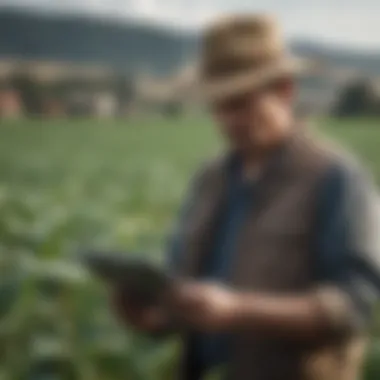Agriculture Trends, Challenges, and Innovations Overview


Intro
Agriculture is at a pivotal point in its evolution. The interplay of technology, climate change, and social dynamics is reshaping the landscape of farming across the globe. Understanding these changes is essential for anyone involved in the sector. New trends are emerging, and old practices are being reevaluated. This section aims to lay the groundwork for a deeper exploration of agriculture's current state, its challenges, and its potential for innovation.
Key Concepts
Definition of Primary Terms
In the context of agriculture, several key terms warrant definition to avoid ambiguity.
- Sustainable Agriculture: This is a method of farming that aims to meet current food needs without compromising the ability of future generations to meet their own food needs. It emphasizes eco-friendly practices, animal welfare, and economic viability.
- Precision Agriculture: This approach utilizes technology to monitor and manage field variability in crops. The goal is to optimize returns on inputs while preserving resources. Techniques often include GPS technology and data analysis.
- AgriTech: Refers to any technology that enables efficiency improvements in agriculture. This includes software, hardware, and innovative practices designed to optimize food production.
Related Concepts and Theories
Several theories relate to the ongoing changes in agricultural practices. The most notable include:
- Theory of Planned Behavior: This theory suggests that individual behavior is driven by intentions, which are influenced by attitudes, social norms, and perceived control. This is crucial for understanding farmers' adoption of sustainable practices.
- Diffusion of Innovations Theory: This model explains how, why, and at what rate new ideas and technology spread. It is vital for understanding how agricultural innovations are integrated into existing systems.
Challenges in Modern Agriculture
The contemporary agricultural landscape faces numerous obstacles. Some key challenges include:
- Climate Change: Variability in weather patterns can lead to unpredictable yields and threaten food security.
- Resource Scarcity: Water shortages and soil degradation are pressing issues that can affect crop production.
- Market Access: Farmers often struggle to connect with markets, limiting their profitability.
Innovations in Agriculture
Innovation is essential for overcoming the challenges faced by farmers today. Key areas of advancement include:
- Biotechnology: Genetically modified organisms (GMOs) and CRISPR technology are leading to crops that are more resilient to pests and environmental changes.
- Drones and Satellite Imaging: These technologies allow for better crop monitoring and management, enabling precise interventions to address specific needs.
- Vertical Farming: This urban farming technique maximizes space efficiency and minimizes resource use, making it possible to grow food in city environments.
Future Directions
Gaps Identified in Current Research
Research in agriculture has made significant strides, yet there remain critical gaps:
- Integration of Technologies: More studies are needed on the integration of blockchain and artificial intelligence into food supply chains.
- Social Impact of Innovations: Understanding how technological advancements affect rural communities is vital but often overlooked.
Suggestions for Further Studies
- Climate Resilience Strategies: Researchers should explore how various farming techniques can be employed to adapt to changing climatic conditions.
- Consumer Behavior Analysis: More comprehensive studies on consumer preferences regarding sustainably produced food could guide farmers and policymakers.
Understanding these essential concepts and their implications can equip stakeholders in the agriculture sector with the insights needed to navigate current challenges. As we proceed, it will become apparent how interconnected these elements are and their collective impact on the future of farming.
Overview of Agriculture
Agriculture is a fundamental pillar of human civilization. It encompasses not only the cultivation of crops and the rearing of animals but also the broader systems that support food production and distribution. In this article, we will explore the essential elements that shape modern agronomy, covering trends, challenges, and innovations. An overview of agriculture lays the groundwork for understanding these aspects and their relevance in today’s world.
The importance of understanding agriculture stems from its intricate relationship with food security, environmental sustainability, and economic stability. As global populations rise, the pressure on agriculture escalates. Stakeholders must adapt and innovate to meet increasing demands while mitigating environmental impacts. Thus, a thorough comprehension of this sector is crucial for students, researchers, educators, and professionals involved in agronomy.
Historical Context
The history of agriculture dates back thousands of years. Early human societies transitioned from nomadic lifestyles to settled farming, establishing the foundation of modern civilizations. The Agricultural Revolution was a pivotal moment, enabling communities to cultivate crops, develop domesticated animals, and consequently support larger populations.
Over centuries, agriculture has undergone significant transformations, influenced by technological advancements, climate dynamics, and socio-economic factors. The introduction of crop rotation, selective breeding, and irrigation systems marked substantial progress. Today's agricultural landscape is shaped by past innovations and challenges, underscoring the importance of historical context.


Global Agriculture Statistics
Current statistics highlight the scale and significance of agriculture worldwide. As of 2021, approximately 40% of the Earth’s land is devoted to agriculture, which includes arable land, pasture, and forests used for farming purposes.
- Food Production: Globally, about 2.5 billion people are involved in agriculture, contributing to the production of staples such as rice, wheat, and maize. These crops are essential for human diets and have immense economic value.
- Economic Contribution: The sector contributes approximately 4% to the global GDP and sustains numerous livelihoods across various regions.
- Sustainability Metrics: However, sustainability remains a pressing concern. Agriculture is responsible for a significant portion of greenhouse gas emissions. Approximately 24% of emissions come from agricultural activities, leading to an urgent need for sustainable practices.
Understanding these statistics offers crucial insights into the challenges and opportunities within the agricultural sector today. By examining historical context and current numbers, stakeholders can make informed decisions that favor both productivity and sustainability.
Current Trends in Agriculture
The agricultural sector is currently undergoing significant transformation, influenced by various trends that aim to optimize productivity and sustainability. Understanding these trends is crucial for stakeholders looking to navigate the complexities of modern farming. The blend of technology, environmental consciousness, and shifting consumer demands shapes how agriculture operates today and into the future.
Sustainable Farming Practices
Sustainable farming practices prioritize the health of ecosystems while aiming for economic viability. These practices incorporate methods like crop rotation, agroforestry, and reduced chemical use. They seek to maintain soil health, conserve water, and promote biodiversity. From a financial perspective, these practices can reduce input costs over time and enhance resilience against climate change. Additionally, as consumers show increasing preference for environmentally friendly products, farmers adopting sustainable methods can often command higher prices in the market. \n Key components of sustainable farming include:
- Soil Management: Employing strategies like cover cropping and reduced tillage to enhance soil structure.
- Water Conservation: Implementing irrigation technologies and rainwater harvesting systems to optimize water use.
- Integrated Pest Management: Using biological and mechanical methods to control pests with minimal chemical inputs.
Sustainable practices not only contribute to a healthier planet but can also improve long-term profitability for farmers.
Precision Agriculture
Precision agriculture embodies the use of technology to optimize field-level management regarding crop farming. It involves data collection through sensors, drones, and satellite imagery to monitor crop health, soil moisture, and nutrient levels. This data informs decisions regarding planting, watering, and harvesting, allowing for more efficient resource use. The benefits include reduced input costs and increased yields.
Technologies in precision agriculture include:
- Geographic Information Systems (GIS): Mapping fields to analyze variability in crop performance.
- Variable Rate Technology (VRT): Adjusting inputs like fertilizer and seed based on specific field conditions.
- Remote Sensing: Leveraging aerial imagery to monitor crop health and identify areas needing attention.
By focusing on site-specific management, precision agriculture offers a pathway toward sustainable practices while also boosting productivity.
Organic Farming Growth
Organic farming has witnessed steady growth, driven by consumer demand for products free from synthetic pesticides and fertilizers. In recent years, organic produce has gained traction within retail markets, catering to a health-conscious audience. This shift emphasizes the importance of ecologically-based practices that support soil health and biodiversity without the use of harmful chemicals.
The growth of organic farming can be attributed to:
- Consumer Awareness: Buyers are increasingly prioritizing organic labels as part of their commitment to healthier lifestyles.
- Regulatory Support: In many regions, governments provide incentives for organic certification and practices.
- Market Expansion: Increased availability of organic products in supermarkets and online platforms.
Farmers transitioning to organic methods often face initial challenges, such as lower yields during the adjustment period. However, the long-term benefits, including better market prices and reduced dependency on chemical inputs, often outweigh these early difficulties.
Technological Innovations in Agriculture
Technological innovations are reshaping the agricultural landscape. These advancements offer solutions to age-old challenges, enhancing productivity and sustainability. Incorporating cutting-edge technologies into traditional practices helps farmers to work more efficiently. As the global demand for food escalates, innovations in agriculture become increasingly vital. They not only improve crop yields but also minimize resource waste, which is crucial for environmental sustainability.
Drones in Agricultural Monitoring
Drones are transforming agricultural monitoring by providing real-time data and aerial imagery. This technology allows farmers to assess crop health from a new perspective. Drones can cover vast areas in a fraction of the time it takes for manual monitoring. They are equipped with high-resolution cameras and sensors capable of detecting variations in plant health. By using drones, farmers can identify issues such as pest infestations, nutrient deficiencies, or water stress promptly.
- Benefits:
- Cost-effective: Less labor and time needed for field surveys.
- Precision: Targeted interventions lead to better resource allocation.
- Data-rich insights: Informs better decision-making by providing accurate assessments of crop conditions.
Biotechnology and Crop Engineering
Biotechnology plays a pivotal role in modern agriculture by developing crops that are more resistant to diseases, pests, and extreme weather conditions. Genetic engineering allows scientists to enhance specific traits in crops, leading to increased yield and reduced reliance on chemical pesticides. This innovation helps address food security challenges by making agriculture more resilient.


- Considerations:
- Ethical concerns: The use of genetically modified organisms raises debates about safety and environmental impact.
- Regulatory frameworks: Different countries have varying regulations regarding biotechnology, which can affect market access for these products.
"Biotechnology is key to meeting future food demands while ensuring environmental sustainability."
Artificial Intelligence and Data Analytics
Artificial Intelligence (AI) is revolutionizing agriculture through data analytics. Large-scale farming generates extensive data, from weather patterns to soil health indicators. AI processes this data efficiently to identify trends and predict outcomes. Farmers can leverage AI to optimize irrigation schedules, manage pest control, and plan crop rotations more effectively.
- Advantages:
- Efficiency: Saves time by automating complex analyses.
- Predictive capabilities: Prepares farmers for potential challenges through forecasting.
- Enhanced decision-making: Supports farmers in making informed choices based on data-driven insights.
Innovations like these in the agricultural sector demonstrate a significant shift towards integrating technology with traditional practices. By embracing these changes, the sector can achieve greater sustainability and productivity, ensuring better food security for future generations.
Challenges Facing the Agricultural Sector
The agricultural sector plays a crucial role in global economy and food security. However, it is beset by numerous challenges that threaten its sustainability and efficiency. Understanding these challenges is vital for stakeholders, including farmers, policymakers, and researchers. This section delves into the pressing issues that modern agriculture faces today. By addressing these challenges, we can work towards solutions that promote a more resilient agricultural landscape.
Climate Change Impacts
Climate change presents one of the most formidable threats to agriculture. It influences weather patterns, affects crop yields, and alters the growing seasons. Farmers are experiencing fluctuations in rainfall and increased frequency of extreme weather events, such as droughts and floods. These changes lead to significant unpredictability in food production.
- Crop Varieties: Certain crops are more sensitive to temperature changes. Adaptation through developing resilient crop varieties is critical, but this requires both time and investment.
- Pest and Disease Pressure: Warmer climates may expand the range of pests and diseases, making it essential to invest in pest management strategies.
- Food Security Risks: The direct impact on agricultural output raises concerns regarding food security, particularly in vulnerable regions.
Addressing climate change impacts involves not just adaptation strategies but also mitigation efforts. Reducing greenhouse gas emissions within the agricultural practices is an important step forward.
"Agriculture must evolve to contend with climate realities that are shifting at an alarming rate. Adaptation is not just necessary; it is vital."
Soil Degradation and Water Scarcity
Soil quality and water availability are foundational to successful agricultural practices. Unfortunately, soil degradation resulting from unsustainable farming practices is widespread. Soil erosion, nutrient depletion, and contamination all contribute to reduced agricultural productivity.
- Erosion: Loss of topsoil diminishes the soil’s ability to retain moisture and nutrients.
- Nutrient Depletion: Over-reliance on chemical fertilizers can lead to long-term soil health issues.
- Contamination: Pesticides and other chemicals can lead to soil toxicity, which further threatens crops and the environment.
Water scarcity presents a parallel challenge. As populations grow and climate change worsens, access to clean water for irrigation becomes increasingly difficult. Strategies for water conservation, such as drip irrigation and rainwater harvesting, are critical for addressing this issue.
Economic Barriers and Market Access
Economic barriers significantly hinder the agricultural sector, especially for smallholder farmers. These farmers often lack access to financial resources, which limits their ability to invest in necessary technologies and inputs.
- Financing Difficulty: Many farmers struggle to secure loans due to lack of collateral.
- Market Fluctuations: Price volatility of agricultural products makes it challenging for producers to maintain consistent income.
- Trade Barriers: International trade policies can create obstacles for farmers trying to access new markets.
Addressing these economic barriers requires coordinated efforts from governments and organizations. Enhancing access to credit, providing market information, and creating supportive policies are essential measures.
In summary, the challenges facing the agricultural sector are interconnected and complex. Each requires urgent attention and strategic action. Stakeholders must engage in discussions and initiatives that promote sustainability and resilience.
Policy and Regulation in Agriculture
The landscape of agriculture is shaped not just by the hands that harvest and the lands that nurture, but also by the policies and regulations that govern practices within the sector. Understanding policy and regulation in agriculture is crucial as it defines how resources are utilized, how farmers adapt to changing conditions, and ultimately how food systems function on a global scale. Given the pressing challenges such as climate change, resource depletion, and market volatility, this section highlights the significance of maintaining a robust regulatory framework that ensures sustainability and equity within agricultural practices.
Environmental Policies and Compliance
Environmental policies form the cornerstone of sustainable agriculture. These regulations aim to minimize ecological footprints while enhancing productivity. One emerging focus is on how farming practices contribute to biodiversity and soil health. Compliance with these policies ensures that agricultural activities do not adversely affect ecosystems. This promotes practices such as crop rotation, integrated pest management, and agroforestry. Regulations often provide frameworks that support farmers in transitioning to more sustainable methods by offering guidelines and standards.


Farmers' adherence to these environmental regulations can also serve as a market differentiator. Certification programs, such as organic or sustainable agriculture labels, attract consumers who prioritize sustainable choices, thus creating economic benefits for compliant farmers. It is critical that agricultural policies incorporate incentives for compliance. These incentives can include grants for adopting green technologies or tax reductions for sustainable practices.
Subsidies and Financial Support
Subsidies play a fundamental role in agricultural policy. Governments often provide financial support to farmers to stabilize income, promote food production, and ensure food security. Such subsidies can take various forms—direct payments, crop insurance programs, and funding for research and innovation. The challenge lies in balancing these subsidies to ensure they do not distort market prices or lead to overproduction of certain crops, which can have detrimental effects on the environment and economy.
By aligning subsidies with sustainability goals, governments can encourage farmers to adopt eco-friendly practices. For instance, financial support tailored to incentivize cover cropping, reduced tillage, or organic farming can effectively transform practices across the sector. It is essential for policymakers to continually assess the impact of these subsidies, ensuring they drive the sector towards resilience against economic shocks and environmental degradation.
Trade Agreements and Their Effects
Trade agreements significantly impact the agricultural sector, determining market access and competitiveness. These agreements can either facilitate or hinder the growth of local agricultural industries. For example, trade liberalization can lead to increased competition from foreign markets, which poses challenges to domestic producers. However, it can also provide access to broader markets for agricultural goods, enhancing economic opportunities for farmers.
Moreover, trade agreements often come with conditions related to environmental and labor standards. Such stipulations can enhance sustainability within trade practices but require comprehensive oversight. Countries must negotiate agreements that reflect their environmental commitments while also protecting their farmers from unfair competition.
The shifting landscape of global trade, influenced by recent geopolitical tensions and changing consumer preferences, underscores the need for adaptive policies that can respond to these dynamics. It is essential for agricultural policymakers to understand the implications of these agreements, ensuring that they balance economic growth with sustainable practices throughout the sector.
Future Prospects for Agriculture
The future of agriculture is a critical subject for various stakeholders. It encompasses the continuous evolution within the sector, driven by emerging technologies, unpredictable climate conditions, and shifting consumer demands. Understanding the prospects for agriculture means recognizing the intricate balance between innovation and sustainability.
Emerging Technologies
Emerging technologies are at the forefront of transforming agricultural practices. These advancements promise to enhance efficiency and productivity while addressing environmental concerns. Significant technologies include:
- Genetic Modification: Advances in biotechnology allow for the development of crops that resist pests and tolerate extreme weather.
- Automation and Robotics: Robotics can automate mundane tasks like planting, watering, and harvesting, reducing labor costs and increasing precision.
- Drones: Drones provide aerial monitoring, enabling farmers to make data-driven decisions regarding irrigation, fertilization, and crop health.
These technologies not only improve yield but also support sustainable practices. By reducing the need for chemical inputs and minimizing waste, they contribute positively to environmental preservation.
Global Food Security Initiatives
Global food security initiatives are essential in tackling the pressing challenges of hunger and malnutrition. The United Nations and various NGOs are spearheading efforts for sustainable food systems. Important initiatives include:
- Food for Thought: Programs aimed at engaging communities in local food production improve access and education on food security.
- Sustainable Development Goals (SDGs): Aiming to eradicate hunger by 2030, these goals emphasize sustainable agricultural practices and investment in rural development.
- Safe Food: Ensuring food safety through regulatory frameworks protects consumers and enhances market access for farmers.
These initiatives not only address immediate food needs but also bolster long-term resilience in agricultural practices, leveraging global partnerships for more efficient resource distribution.
Adapting to Consumer Preferences
As consumers become more aware of the impact of their choices, the agricultural sector is adapting to meet these demands. Key trends include:
- Organic Products: The shift towards organic farming reflects growing preferences for health-conscious and environmentally friendly options.
- Traceability: Consumers seek transparency regarding the origins and production methods of their food, prompting farmers to adopt traceability systems.
- Plant-Based Diets: The rise in plant-based diets requires an adaptation in cultivation practices and the development of diverse crops to meet new market needs.
Understanding and responding to these changing preferences is crucial for the agricultural sector to thrive in the future.
The ability of agriculture to adapt to both technological advancements and consumer expectations defines its future trajectory.
End
Summary of Key Points
The agriculture sector is at a crucial intersection of technology, sustainability, and policy challenges. Throughout this article, we explored trends such as sustainable farming practices, precision agriculture, and the rise of organic methods. Innovations like drones and biotechnology are reshaping how we approach farming, offering tools that can enhance productivity and reduce environmental impacts. However, the industry must grapple with significant challenges, including climate change and economic barriers. Effective policies and regulations are needed to guide developments and ensure the balance between productivity and sustainability.
Some key points include:
- Technological Innovations: The integration of AI, drones, and biotechnology is revolutionizing farming techniques.
- Sustainability: Emphasis on sustainable practices to mitigate climate impacts and promote soil health is emerging.
- Economic and Policy Barriers: Challenges like market access and the need for supportive policies are pressing issues to address.
Call for Continued Research and Innovation
As we move forward, the necessity for ongoing research and innovation in agriculture remains paramount. The sector faces a landscape that is rapidly changing due to environmental and societal factors. Research must focus on developing resilient crops, efficient water usage strategies, and sustainable land practices. Collaborative efforts between scientists, policy makers, and farmers can lead to innovative solutions tailored to local needs.
Furthermore, innovations should consider consumer preferences shifting towards organic and sustainably produced food. Embracing new technologies while respecting traditional practices can create a more balanced approach that optimizes agricultural output.



